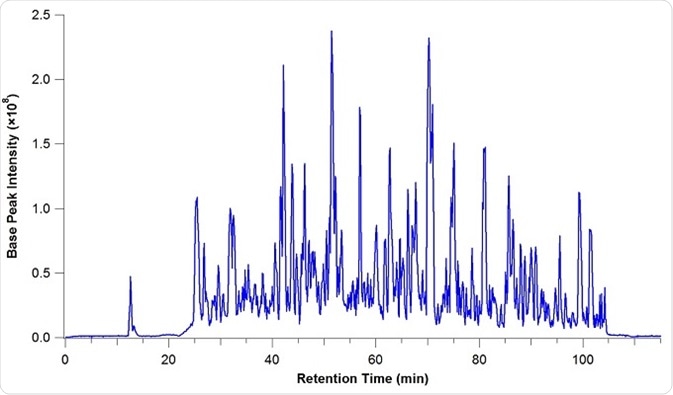Targeted Metabolomics
Metabolome can be described as the terminal output of the genome that comprises the overall complement of metabolites (molecules with low molecular weight) in an organism or cell. The technique of measuring molecules is divided into two groups: targeted metabolomics and untargeted metabolomics. The wide range measuring of known metabolite molecules in a disease state or in physiological stimuli is called targeted metabolomics.
Understanding targeted metabolomics
Targeted metabolomics is a quantitative approach where a group of metabolites are quantitated with the help of 15N or 13C (internal or external) compounds that are known as labeled isotopes. Additionally, with the internal standard help, the analysis can be done by semi-quantitative or quantitative methods.
This method of analyzation helps in the overall understanding of the massive array of metabolites in the end products (like sweat, urine, etc.) in addition to its kinetics. And, to attribute the known pathways of biochemicals that they subsidize, statistical analysis uses this data (outcome) as the input variable.
The core panel of the metabolomics comprises several metabolites such as organic acids, drugs, neuromodulators, and byproducts of intermediary metabolism that happen within a cell. These panels are known components that are used by investigators in their case analysis.
Making use of this targeted metabolomics, the sample preparation is optimized. This restricts the dominance of the molecules of high-abundance in the analyses.
Nature review comparing untargeted and targeted metabolomics.
Characteristics of targeted metabolomics
As mentioned above, the role of targeted metabolomics is to evaluate the set of interpreted and biochemical metabolites. This type of restricted coverage of metabolome proves that the targeted metabolomics rely on metabolites and their biochemical pathways. This makes the discovery of metabolic perturbations complicated. Moreover, with the usage of labelled standards, the targeted metabolomics are quantitative.
This creates a platform to establish the clear exhibition of physiological processes. The perfect explanation of metabolites in the species minimizes the prospects of analytical artifacts to ensure the data analysis. Targeted metabolomics is also capable of producing specialized extraction techniques.
Factors involved in targeted metabolomics
Metabolite extraction
Sample preparation through metabolite extraction is the most essential process whose outcome in the proper quantification of the targeted metabolites. As far as untargeted metabolomics is considered, the method of extraction should release the wide range of metabolites through the sample. Whereas in targeted metabolomics, there are only a few metabolites analyzed. The focus of this method should be on the streamline extraction of the needed metabolites.
Hence, the method of extraction is customized to the relative abundance and physicochemical attributes of a metabolite subset that is to be analyzed. When the exclusion of components takes place, the metabolites and proteins are not intentional for the analysis. A range of factors is considered in the extraction process. They are liquid–liquid, biphasic or monophasic in nature, pH, temperature and the ratio of aqueous and organic solvents.
The metabolite extraction is capable of affecting the productivity of the examination and the nature and the quantity of the extracted metabolites, if any disruption occurs.
Liquid chromatography–mass spectrometry (LC-MS)
Every single metabolite has its own unique ions that undergo specific transition processes. With the help of these transition states, the uniqueness of the metabolite will be ascertained if combined with a chromatographic retention. Hence, all the retention times, transitions, collision, and concentration range for the metabolite can be derived with the help of targeted metabolomics.
The LC-MS methods of analyzation with targeted metabolomics are known to produce the result of both the ionization (positive and negative).
There are several considerations taken into account when experimenting with LC-MS in targeted metabolomics. It sometimes affects the experimented quality of the data. Therefore, opting for the exact ionization parameters is essential.
The Electrospray ionization (ESI) is known as the most common and efficient method of ionization performed in LC-MS-related experiments. This ionization process is also called as the technique of soft ionization. The chemical derivatizations are not required in ESI technique to improve the volatility. It also helps in reducing the fragmentation that helps in the analytical interpretation.

An example base peak chromatogram from an LC-MS analysis.
Author: licensed under the Creative Commons Attribution-ShareAlike 3.0 License. CWenger/ en.wikipedia.org.
Advantages of targeted metabolomics
The MS-based metabolomics is difficult to identify as the retention time of the chromatographic and ion intensities undergo a temporal drift. Due to this, the demo analysis for the study must be done in a variable manner and on the same day and batch the data must be acquired. This in return minimizes the variations that occur in the sets.
The targeted metabolomics plays a two-fold aspect in this analysis:
- In the first aspect, the sample influenced by the internal standards helps in regulating the metabolites’ concentration in the samples. This process is used to analyze the massive sample sets, which take more days or weeks to complete.
- In the second aspect, the accurate identity of each metabolite is defined with the help of Multiple Reaction Monitoring (MRM) analysis. These types of MS analyses are made with the help of an instrument called triple quadrupole.
Sources:
- http://depts.washington.edu/nwmrc/services/targeted-analysis
- https://www.ncbi.nlm.nih.gov/pmc/articles/PMC3334318/
- http://www.creative-proteomics.com/services/targeted-metabolomics.htm
- http://journals.plos.org/plosone/article?id=10.1371/journal.pone.0089728
- http://cmcr.columbia.edu/metabolomics/targmeta.html
- https://www.bruker.com/applications/life-sciences/metabolomics/targeted-metabolomics.html
- https://www.danforthcenter.org/scientists-research/core-technologies/proteomics-mass-spectrometry/services/targeted-metabolomics
- http://www.mayo.edu/research/core-resources/metabolomics-core/services/targeted-metabolomics
- http://onlinelibrary.wiley.com/wol1/doi/10.1002/anie.200905579/full
Further Reading
- All Metabolomics Content
- What is Metabolomics?
- Applications of Metabolomics?
- Metabolites – What are Metabolites?
- History of Metabolomics
Last Updated: Feb 26, 2019
Source: Read Full Article
